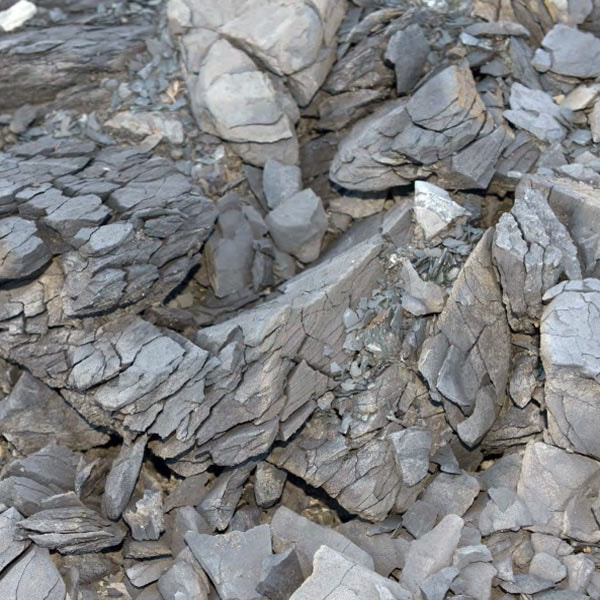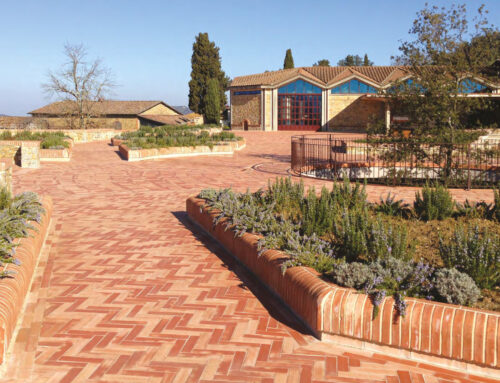What is Terracotta Clay of Impruneta and where does it come from
 If we want to discover how the clay that has always been used for the production of terracotta was formed, we have to go back very far in time and space.
If we want to discover how the clay that has always been used for the production of terracotta was formed, we have to go back very far in time and space.
Our voyage would begin about two hundred million years ago, in the middle of what is now the Tyrrhenian Sea. At the bottom of the Ocean of Tethys, thousands of meters deep, with extreme conditions of temperature and pressure, where residues of the disintegration of the immersed surrounding lands were accumulating. Coastal plains periodically invaded by tides which bordered the area to the east and south with landscapes very similar to today’s tropical areas, with calcareous and evaporitic deposits. Movements of the earth’s crust then caused deep lacerations through which magma could reach the surface of the sea, increasing the temperature of the water and contributing to the transformation of the rocks.
It is now recent history, a little more than twenty million years ago, when two strips of the earth’s crust began to roll towards the east to the point Corsica and Sardinia are located today. It was for this reason that all the materials accumulated at the bottom of the sea began to compress themselves, forming blocks and scales that overlapped to create a new mountain chain: the birth of the Apennines.
Masses of twisted layers were displaced by enormous amounts of malleable sediment involved in orogenesis. It was soils of this type and development that formed a large part of our territory, conditioning, because of their very nature, the morphology of every single slope and every single embankment that have been studied for years to try to understand the complexity of the events that occurred. A very difficult task for the geologists who intend to decipher this puzzle, since they must try to penetrate what remains today, still visible with difficulty – unsettled and uneven masses of rocks that are still in movement, as recurrent landslides and earthquakes demonstrate.
One understands why until a few years ago these geological units were charted using vague and generic definitions such as chaotic and undifferentiated as proof of how difficult it was to catalog them. Even at a microscopic level heterogeneity is the characteristic of this clay which is taken from the excavation and shattering of the rock and which can only be worked on during the summer months, treating it with continuous cycles of sunshine and sifting. In this way the larger blocks of stone can be progressively removed, refining and dehydrating the raw material more and more prior to work in the furnaces. Clayite returns to being the clay that deposited itself deep in the ocean more than two hundred million years ago, but enriched during its long journey by the minerals of the many rocks that had formed in the meantime.
It is evident that it is exactly this special genesis that produces the best quality in the finished product, through the various physical and chemical transformations of the mineral components under the effect of the temperature during the passage from raw material to a stable brick. It is only because of its particular mineralogical mix that terracotta assumes its well-known mechanical characteristics which render it unalterable to atmospheric agents and abrasion, qualities that have always been appreciated and valued for various uses including as a construction material.
The typical area of production of Ferrone, with its continuous outcrops of such particular clays and the presence of a rich course of water like the Greve river, was able to develop also because of other specific elements of geography and history. Already in
Roman times the old settlement was located along the route of the Hadrian Cassia which ran into the Volterra road and consented a rapid access towards Florence. In particular, it was precisely the expansion of that city and the demographic and economic growth of its countryside with its splendid villas in the Renaissance period that later represented the reasons for a constant growth of the sector in terms of quantity and quality It was therefore almost inevitable that even Brunelleschi, called in for the construction of the Duomo of Florence, went as far as the ridge of San Giusto in Monterantoli to discover a marble of a particular reddish color which would embellish the façade of Santa Maria del Fiore.
But probably not before having visited some of the furnaces situated along the Greve river, a few kilometers from there, to commission the bricks and tiles to cover his splendid Dome which he then had constructed under his direct control. So one can venture to say that the most important component that renders Florentine terracotta so special is an immaterial component such as time. One can get dizzy thinking that more than two hundred million years had to pass in order that the deposits accumulated at the bottom of the ocean returned to the surface. It is only thanks to this very long interval that these materials were able to enrich themselves and modify themselves in terms of mineralogy and petrography.
It is exactly thanks to time that one can exhalt the quality of terracotta to the maximum – through its passage in the furnace it finds again the nature and the essence of the rocks that it derives from. To verify this it is not indispensable to go to Brunelleschi’s Dome. Fortunately there are still some uninhabited ruins in our area. It is here that one must look for our bricks and our tiles, the old pots at the entrance of the house, even more beautiful after decades of abandon under the snow or under the sun, just waiting for time to pass.
At the beginning of the first century AD, when terracotta tiling started to be used on a widespread basis in the buildings of Imperial Rome, many rooms in residential buildings as well as in public areas were floored with tiling elements in different shapes and sizes. Large square (pedal, bipedal and sesquipedal) or rectangular tiles were used not only for flooring rooms in shops and large warehouses, but also for service areas in baths and amphitheaters. Instead, small tiles (about 2×10 / 12×5 cm) laid according to an opus spicatum design were used for flooring in porticoes, vestibules, courtyards and public areas throughout the Imperial Age.
More unusual shapes such as rectangles, rhombuses, small cubic tesserae, almond-shaped elements, hexagons (some of which even had marble tessera insets in the middle) and octagons were used to create highly distinctive and elaborate geometric floor patterns. The combining mechanism that, as early as Roman times, started with basic elements to culminate in the creation of floor patterns (i.e. the “textures” referred to in the title of this section of the catalogue) is clearly immediate and direct, although it is not always unique in terms of the design results that could be achieved. Based on the examples found to date and unearthed at archeological sites – in contrast with a significant number of basic geometric elements (the square in various sizes, the rectangle, the hexagon, the rhombus and so on) – early terracotta flooring in the Roman tradition has revealed a range of textures based on even, regular and repetitive laid floors that created flooring surfaces with a uniform and generally monochromatic geometric field. This homogeneous effect is the result of the consistent combination of elements with a single shape and size
Order, simplicity and regular designs are the components that constituted the rise of Roman flooring textures. More detailed and unique research into flooring interpretations examined the combination of terracotta elements with different geometric and size formats, the use of clayey paste in different shades of color, the treatment of the fields with complex geometric or even figurative motifs, the development of a flowing and hierarchical view of the flooring project itself (with a focus on specializing in compositional subthemes such as centers, more elaborate textures, frames, fasciae around the edge), and so on. These were subjects that later historical periods would explore properly and extensively through specific and unique figurative cultures, thereby enriching the more limited repertoire of the textures used by the Romans. Nevertheless, this repertoire, in and of itself, was already important from its very origins and was able to “guarantee the continuation” of the repertoire that, over the course of more than two thousand years of history, came to represent the typically Italian tradition – noble yet plebeian at the same time – of terracotta floors.


